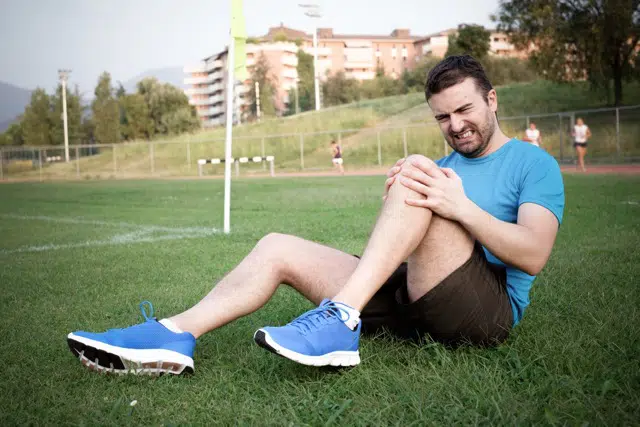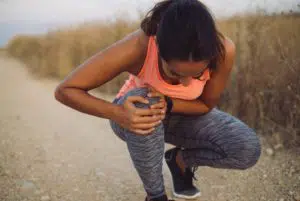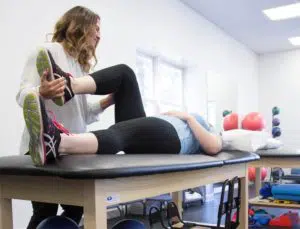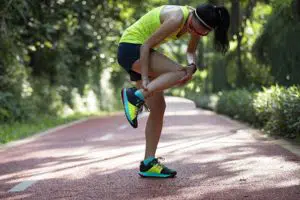
Whether you are an ultramarathoner or a weekend warrior who enjoys casual runs, you most likely run into knee-related pain. Knee pain is one of the most common running-related injuries and affects about 55% of recreational runners. There are many different causes of knee pain or knee-related injuries, few of the most common knee injuries include patellar tendonitis, patellofemoral pain, iliotibial band pain, and strains/sprains.
Runners' knee or patellofemoral pain is the most prevalent of injuries listed. Patellofemoral pain is pain in the front of the knee and around the kneecap due to cartilage damage. It is typically an overuse injury with more than one cause with atypical running mechanics being one of the crucial risk factors.
Patellofemoral pain is one of the most common running-related knee injuries affecting 20-22 percent of runners.
Many causes of runners' knees are often multifactorial. One of the biggest regions that affect the mechanisms related to patellofemoral pain is the hip. The compensations we typically see associated with patellofemoral pain due to muscle imbalances or structural abnormalities include increased hip adduction (knee falls more toward the midline), hip internal rotation (the leg is typically rotated inward to a degree), and contralateral pelvic drop (the side of the pelvis opposite the stance leg drops).

All participants experienced a reduction in pain and improved biomechanical function while running. The average pain rating of the participants at the beginning of the study was 6.2 on a scale of 0-10, with 0 being no pain and 10 being the worst pain. At 4 weeks that average dropped to 1 out of 10 and at 3 months, the average pain had decreased to .3 out of 10. All participants displayed statistically significant improvements in the three functional deficits listed earlier (increased hip adduction, hip internal rotation, and contralateral hip drop).
If you are experiencing patellofemoral pain, this is a good place to start. You can always increase your cadence by about 10%, decrease your mileage, or try adding in another cardio activity such as rowing, biking, or swimming that decreases the compressive load on the knee.
Patellar tendonitis is another overuse injury that is defined by the pain in the tendon that connects the kneecap to the tibia (the shin bone). Many of the things that cause patellofemoral pain can also lead to patellar tendonitis. The first thing to do when this pain presents is to rest, decrease mileage, or modify your activities to those that decrease the strain on the patellar tendon.

Treatment options outside of those just mentioned include therapeutic exercise, ice, Class 4 laser therapy, dry needling, ultrasound therapy, and many more. A few exercises you can try if you start experiencing this type of pain include wall sits, slow squats, or “sissy” squats. Some general quad stretches or foam rolling will help decrease the tension on the patellar tendon and should help relieve some of the symptoms.
Iliotibial band pain is also common with runners.
The iliotibial band is an extremely strong piece of connective tissue to which the gluteus Maximus and tensor fascia lata attach.
Many of us spend our time trying to foam roll the outer thigh only to discover no change in the discomfort or tension we are experiencing. That’s because, no matter how much we massage or pound on that band of connective tissue, there will be no change in our symptoms unless we decrease tension in the muscles that act upon it.

As stated previously, there are many causes of knee pain associated with running. If you find yourself experiencing any of these symptoms, try adding in the exercises or exercise modifications. If the symptoms persist, consider reaching out to a healthcare professional.
Knoxville Spine and Sports offers quality chiropractic care and physical therapy to help you with runners’ knee pain relief. Make running fun again!

8029 Ray Mears Blvd, Suite 300
Knoxville, TN
37919
Phone: 865-337-5574
Monday
7am-12pm & 1pm-6pm
Tuesday
7am-12pm & 1pm-4pm
Wednesday
7am-1pm
Thursday
7am-12pm & 1pm-6pm
Friday
7am-12pm & 1pm-4pm
Saturday & Sunday
Closed